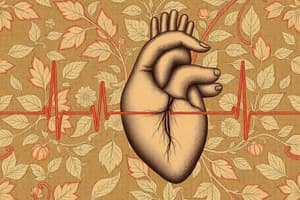Podcast
Questions and Answers
What is the normal range for rectal temperature?
What is the normal range for rectal temperature?
- 38.2 - 39.5 °C
- 35.1 - 36.2 °C
- 39.6 - 40.0 °C
- 36.3 - 38.1 °C (correct)
Which condition is a contraindication for taking a rectal temperature?
Which condition is a contraindication for taking a rectal temperature?
- Asthma
- High platelet count
- Neutropenia (correct)
- High heart rate
What part of the nervous system decreases heart rate?
What part of the nervous system decreases heart rate?
- Vagus Nerve
- SA Node
- Parasympathetic Nervous System (correct)
- Sympathetic Nervous System
In adults, what is the normal range for pulse rate?
In adults, what is the normal range for pulse rate?
Which factor can stimulate the vagus nerve and cause heart rate slowing during rectal temperature measurement?
Which factor can stimulate the vagus nerve and cause heart rate slowing during rectal temperature measurement?
What is the normal range for Tachycardia in terms of heart rate (HR)?
What is the normal range for Tachycardia in terms of heart rate (HR)?
Which of the following best describes the Pulse Amplitude Scale grading of +3?
Which of the following best describes the Pulse Amplitude Scale grading of +3?
In pulse physiology, what does a weak and thready pulse quality indicate?
In pulse physiology, what does a weak and thready pulse quality indicate?
When assessing pulse rhythm, what does it mean if the beats and pauses occur at unequal intervals?
When assessing pulse rhythm, what does it mean if the beats and pauses occur at unequal intervals?
Which equipment is typically used for assessing the apical pulse?
Which equipment is typically used for assessing the apical pulse?
What is the purpose of assessing apical pulse over the apex of the heart?
What is the purpose of assessing apical pulse over the apex of the heart?
What does a pulse deficit (difference between apical and radial pulse rates) indicate?
What does a pulse deficit (difference between apical and radial pulse rates) indicate?
Where does the exchange of oxygen and carbon dioxide occur between alveoli and circulating blood?
Where does the exchange of oxygen and carbon dioxide occur between alveoli and circulating blood?
What is the role of chemo receptors in respiratory control?
What is the role of chemo receptors in respiratory control?
Which statement accurately describes respiration as a vital sign?
Which statement accurately describes respiration as a vital sign?
What is a reason for using the popliteal artery to assess blood pressure?
What is a reason for using the popliteal artery to assess blood pressure?
Why might falsely high blood pressure assessments occur?
Why might falsely high blood pressure assessments occur?
What range is considered normal for oxygen saturation levels?
What range is considered normal for oxygen saturation levels?
Which of the following factors does NOT affect oxygen saturation?
Which of the following factors does NOT affect oxygen saturation?
Why is pulse oximetry useful for monitoring patients?
Why is pulse oximetry useful for monitoring patients?
Flashcards are hidden until you start studying
Study Notes
Vital Signs
- Normal range for rectal temperature is not specified (but generally 36.5°C - 37.5°C)
- Rectal temperature measurement is contraindicated in patients with rectal bleeding, bleeding disorders, or anal fissures
Heart Rate
- Normal range for pulse rate in adults is 60-100 beats per minute (bpm)
- The parasympathetic nervous system, specifically the vagus nerve, decreases heart rate
- Stimulating the vagus nerve during rectal temperature measurement can cause heart rate slowing
- Tachycardia is defined as a heart rate above 100 bpm
Pulse Assessment
- Pulse Amplitude Scale grading of +3 indicates a pulse that is very strong and full
- A weak and thready pulse quality indicates decreased peripheral circulation
- Unequal intervals between beats and pauses during pulse rhythm assessment indicate irregular rhythm
- The stethoscope is typically used for assessing apical pulse
- Apical pulse is assessed over the apex of the heart to detect cardiac irregularities and murmurs
- A pulse deficit (difference between apical and radial pulse rates) indicates a cardiac irregularity
Respiratory System
- Oxygen and carbon dioxide exchange occurs between alveoli and circulating blood in the lungs
- Chemo receptors play a role in respiratory control by detecting changes in CO2 and O2 levels
Blood Pressure
- Respiration is a vital sign that can be affected by changes in blood pressure
- The popliteal artery is used for assessing blood pressure in certain situations (e.g., peripheral artery disease)
- Falsely high blood pressure assessments can occur due to incorrect cuff size or improper technique
Oxygen Saturation
- Normal range for oxygen saturation levels is 95-100%
- Factors that do not affect oxygen saturation include room temperature and humidity
- Pulse oximetry is useful for monitoring patients because it provides continuous, non-invasive oxygen saturation and heart rate monitoring.
Studying That Suits You
Use AI to generate personalized quizzes and flashcards to suit your learning preferences.




